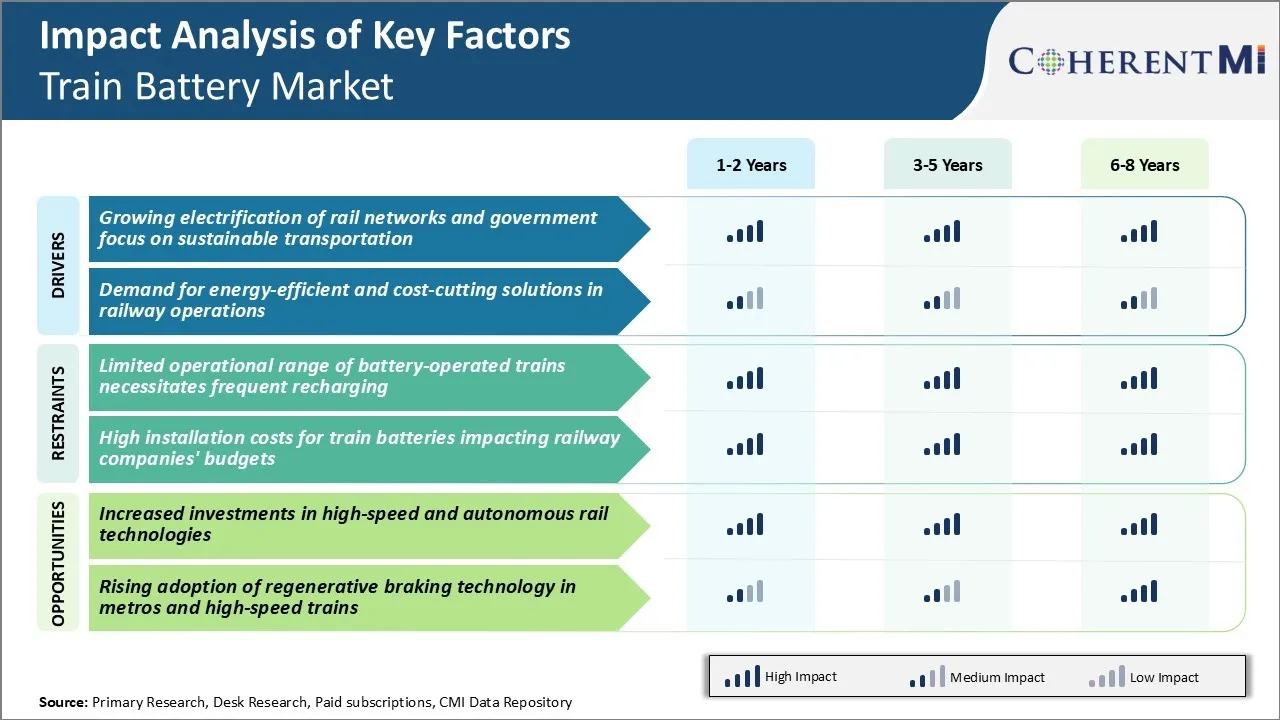Train Battery Market Trends
Market Driver - Growing Electrification of Rail Networks and Government Focus on Sustainable Transportation
Global shift towards more environmentally-friendly modes of transportation has been pushing rail electrification at an unprecedented rate. Governments across major economies have declared ambitious targets and roadmaps to electrify large sections of their rail infrastructure by using train batteries.
Trains powered by electricity result in close to zero direct emissions and are much more energy efficient compared to diesel locomotives. Several countries in Europe have long electrified their mainline networks to a large extent. However, even these nations are now looking to electrify smaller branch lines and regional networks, which will further boost demand for train batteries.
In recent years, many developing economies in Asia and Latin America have also significantly ramped up investments to expand electrified rail corridors through the use of train batteries. This is evident from China's bold nationwide plan to achieve 100% electrification by 2050. India too has unveiled mega plans such as the dedicated freight corridors and high-speed rail projects, where electrification is a key design aspect.
This is expected to boost growth of the train battery market around the world, in the coming years.
Market Driver - Demand for Energy-efficient and Cost-cutting Solutions in Railway Operations
Rail operators across the world are under constant pressure to improve operating efficiencies and optimize maintenance costs. Additionally, the maintenance requirements of diesel engines are considerably higher compared to electric traction systems. Train batteries that can provide 'last mile' connectivity beyond electrified tracks or provide supplementary power are ideal solutions to improve energy efficiency of line operations.
Many railroad companies have started pilot trials of train battery technology on shunting locomotives, maintenance cars, and passenger coaches. The ability of lithium-ion train batteries to deliver high energy density in a lightweight package makes them very suitable for retrofitting in existing rail assets.
Train batteries also enable greater flexibility of train movements that were earlier restricted by geographical constraints of electrified sections. As more innovative battery-electric solutions prove their reliability and cost-effectiveness in real-world railway applications, their adoption will sharply accelerate train battery market in the foreseeable future.

Market Challenge - Limited Operational Range of Battery-Operated Trains
One of the key challenges currently facing the train battery market is the limited operational range of battery-powered trains between charges. Traditional lithium-ion battery technology provides trains with a range of only 100-200 kilometers before the batteries need to be recharged. This poses logistical difficulties as it necessitates frequent recharging stops during operations, disrupting schedules.
Additionally, the substantial weight of the large battery packs required to achieve even this limited range significantly cuts into the payload capacity of trains.
Train battery technology will need to be considerably advanced to achieve higher energy densities and specific energies. This can help in providing battery-powered trains with operational ranges comparable to diesel counterparts, which can travel over 1000 kilometers on a single fuel tank. Thereby, achieving long operational range with the use of train batteries can limit growth of the train battery market.
Market Opportunity - Increased Investments in High-Speed and Autonomous Rail Technologies
Governments and private investors around the world are increasingly committing large amounts of capital into the development of advanced high-speed and autonomous rail infrastructure projects. Such modern rail systems provide a massive potential for train battery market.
Cutting-edge high-speed trains capable of traveling at over 300 km/h will depend on lightweight yet powerful battery packs. Autonomous subway networks and freight rail lines also present opportunities for train battery suppliers to electrify train fleets of the future.
With projected investments in rail projects exceeding $2 trillion over the next decade, the demand for train batteries optimized for rail applications is expected to grow tremendously. This growing funding environment enhances the business case for battery manufacturers to intensify R&D to develop trains batteries meeting the stringent performance requirements of next-generation transportation technologies.